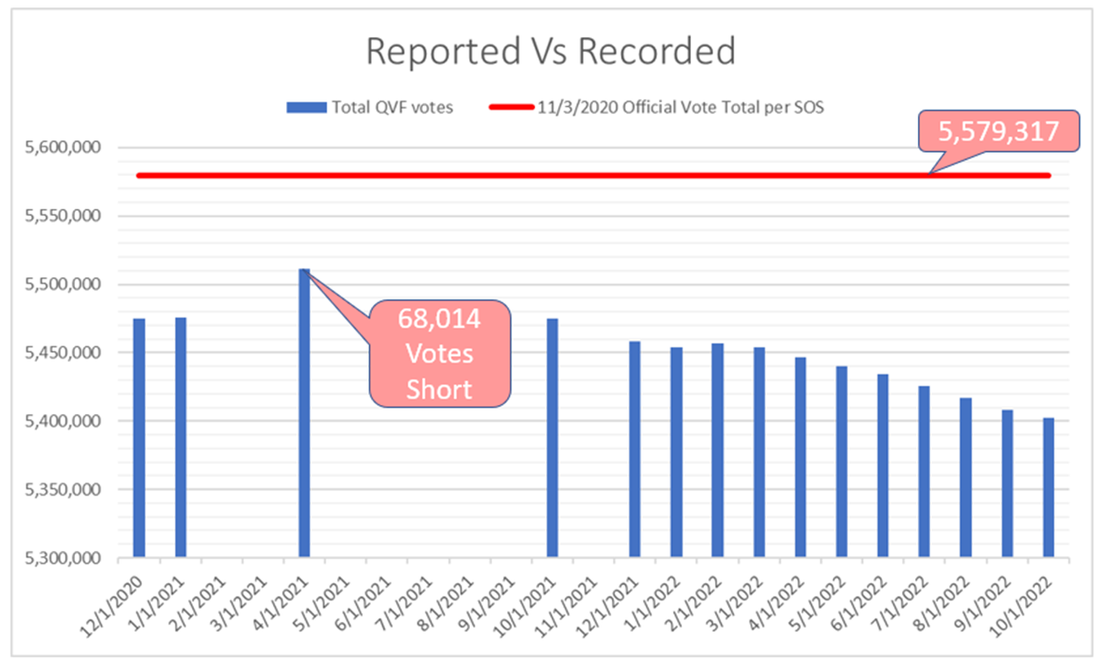According to Michigan SOS Benson, in her testimony on May 12th, 2021, “The 2020 election was the most safe, secure and accessible in our state’s history. This truth was affirmed through more than 250 audits conducted throughout our state by bipartisan groups of election administrators.”1
Looking for answers, an initiative kicked off after the election. Election Integrity Force (EIF) started to use “Freedom of Information Act” (FOIA) requests to obtain “Qualified Voter Files” (QVF) on a periodical basis.
If this truly was the most safe, secure, and accessible election in Michigan’s history, the records should reflect that sentiment. Voters’ election history are required to be recorded in the statewide Qualified Voter File seven days after an election, per MCL chapter 168.509 & 168.813.5.
According to the Michigan SOS’s office, the total turnout for the November 3rd, 2020 general election was 5,579,3172. Over the past two years, EIF has collected multiple QVF records and compared them against the supposed turn out from Nov 3rd, 2020.
The QVF has never reached the reported numbers as listed on the SOS website. The first QVF FOIA from Dec 1st, 2020, shows 104,137 missing votes. The closest the QVF gets to being accurate is from the April 1st, 2021 data, 68,014 recorded votes short of the reported number.

EIF compiled a unique list of voters from those who were added or deleted over the 2 year period after the election. The total number of voters in the 2020 election seem to decrease, as seen in the graphic above. However, the unique list captures the additions to the 2020 election in a cumulative amount. This list was compared against another FOIA from the SOS, whose requester was Patrick Colbeck. After almost 2 years from the Nov 3rd, 2020 election, this is the best the SOS could manage…
November 3rd, 2020
|
SOS Reported Turnout |
EIF Cumulative List |
Colbeck FOIA to SOS 2021-2022 |
|
5,579,317 |
5,558,327 |
5,557,171 |
|
|
-20,990 |
-22,146 |
The SOS response, almost 2 years after the election was completed, resulted in 22,146 voters short.
The cumulative EIF list is 20,990 voters short.
In all walks of business, from healthcare to automotive, external audits are used to ensure proper adherence to law and help protect the industry from fraudulent / criminal activity. The evidence provided above shows the difference of reported results versus recorded results. It took 2 years to compile this list and it is still incomplete. How can citizens trust elections if the process is broken or incomplete?
This lack of accuracy raises a question...are the internal audits touted by the SOS working? If anything, this information increases the need for external audits. EIF will continue identifying errors, inaccuracies, and potential criminal activity across the state.
The fight for transparent and trustworthy elections presses on!
Donate to the Election Integrity Force here
Volunteer with the Election Integrity Force here
Sign up to be a poll challenger through the Election Integrity Force here
Source1: https://www.michigan.gov/-/media/Project/Websites/sos/30lawens/Committee_testimony_5_12_21.pdf?rev=d58678c4e18b4350862a5b6df58ccdd1
Source2: https://mielections.us/election/results/2020GEN_CENR.html




4 comments
Will you update your report to acknowledge that the final, authorized results from 2020 show that only 5,539,302 votes for president were cast in MI? That amount falls within the QVF number according to your FOIA requests, so it turns out there was nothing fishy after all.
Is the percentage the same for all precincts, jurisdictions and counties? or are there problem areas that stand out like the missing inperson names? has this been updated since they added those names?
No election should EVER be certified unless 100% of voters are identified AND accounted for in the SOS’s Qualified Voter File.
Even with canvass boards the SOS is unable to keep an accurate count or history. The count should not change with time. This shows a complete failure of the MI SOS to administer a database and preserve historical records.